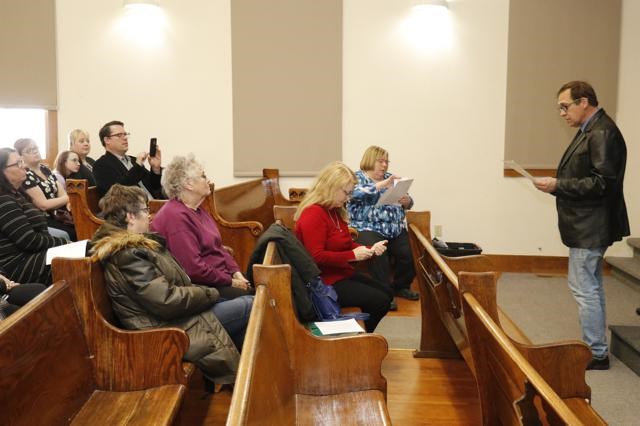Much more work needs to be done to ensure safety for Saskatchewan workers on the job, those attending the Day of Mourning ceremonies heard on Sunday afternoon at the Tommy Douglas Centre in Weyburn.
The annual event was hosted by the Weyburn and District Labour Council, and the ceremonies were all held indoors due to the mix of rain and snow falling outside.
There were two guest speakers who related their experiences in dealing with injuries and death in the workplace, a candlelighting ceremony was held and the names of the 48 people who died on the job in Saskatchewan in 2018 were read out.
Workplace accidents are preventable, said Wanda Bartlett, president of the Labour Council, and injuries are severely under-reported.
There needs to be more prevention of injuries and deaths in the workplace, she added, and she urged the provincial government to reinstate the pre-2014 standards that included the worker’s right to refuse work that is dangerous.
“We owe it to the families who’ve lost loved ones,” said Bartlett. “We mourn for the dead, but we fight for the living.”
Brad Thompson, who is an emergency response team coordinator for the United Steelworkers Union, spoke about some of his experiences in responding to scenes of workplace accidents and fatalities.
Referencing the 48 workers who died in Saskatchewan last year, he said, “Every one of those people were trying to make a living, but they lost their lives.”
He said in every instance where someone has been killed or hurt on the job, there was something wrong, such as a failure to identify a hazard in a workplace, or a failure by the worker to refuse to do something that was dangerous.
“Part of my role is to tend to the needs of the family of the victim. Usually I meet them in the hospital … They need help to make arrangements, but they’re trapped in the hospital. Most are lucky enough to have a support system, but they need help too. The family may need someone to talk to, someone to help arrange things while they focus on their family member,” he said, adding he also works with the local union to do whatever he can to help.
“For the most part, the union and the employer have been open and welcoming of our assistance,” said Thompson, noting that in nearly every case there are identifiable hazards that could have been addressed in the workplace. “We can all do better.”
Thompson recalled responding to one workplace accident where a worker lost his right arm two weeks before his retirement, and he had to comfort the man’s daughter who cried about where her daddy’s arm was.
In another instance, he helped a cab driver who had been attacked by a fare and left for dead. The cabbie was severely injured and wasn’t expected to live, but he survived, and asked the union to work to help make working conditions for cab drivers safer.
A former emergency room nurse, Nancy Styles, also spoke about some of her experiences, noting it hit her one year while hearing a list of names read out at such a ceremony to hear a name of someone she personally knew.
“Death is not the only thing that’s happening. There are aspects of workplace safety that’s not immediately apparent,” she said, noting a victim of a workplace accident could face a life of debilitating pain, or lingering psychological effects of an injury.
Noting that workplace injuries are under-reported, Styles recalled there were a number of times when in the course of treating a patient, she had to go back to the front desk to tell them what the cause of the injuries were.
She fully supports the workplace safety program that is available online to teenagers to take, and said there needs to be more of these types of programs so young people are more aware that they have rights as workers, and that safety is vitally important on the job.
“Workplace safety is everyone’s business, and everyone’s concern,” said Styles. “You may not think you can effect change, but you can.”
She gave the Westwray law as one example where change can be made as the result of a tragedy, and more recently, in the aftermath of the Humboldt Broncos bus crash, there are now new stringent requirements for all semi drivers to follow before they get their licence to drive.



